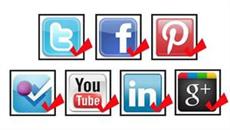Watch: As Facebook reports a rise in mobile advertising revenue, analysts say Asia offers the firm plenty of room to grow further.
There have been doubts over Facebook’s ability to sell adverts on mobile devices, not least due to their small screen size. Investors had feared that its growth may be hurt as a result.
However, Facebook said 30% of its $1.25bn (£803m) advertising revenue in the first quarter came from mobile.
It reported a net profit of $219m for the January to March quarter.
“We’ve made a lot of progress in the first few months of the year,” said Facebook’s founder Mark Zuckerberg.
But increased spending on infrastructure, together with the fact the firm now employs more people than it did a year ago, contributed to a 60% jump in costs and expenses to $1.1bn in the quarter.
‘They are delivering’
Ever since its launch, Facebook has enjoyed tremendous growth and has gone on to dominate the social networking sector.
However, an increasing number of users are accessing the site on their mobile devices such as smartphones and tablet PCs.
The screens of these gadgets are much smaller compared with traditional PCs or laptops. That had led to concerns that Facebook may find it tough to sell advertising space on these and turn its online dominance into profits.
These concerns have hurt the firm’s share price ever since its high profile initial public offering (IPO) last year.
However, analysts said the latest numbers indicate that the firm is keeping up with changing patterns.
“They are making the transition to mobile faster than anyone anticipated,” said Arvind Bhatia, an analyst with Sterne Agee. “It seems like they are delivering.”
According to Facebook, it generated mobile advertising revenue of almost $375m, during the period, up from nearly $330m in the previous three months and approximately $150m in the three months to 30 September 2012.
‘In full force’
Facebook also reported an increase in users who access Facebook every day, these, on average, rose 8% from December to 655 million in March.
That had been another area of concern for investors, amid talk of so-called “Facebook fatigue” among users.
Analysts said the numbers indicated that the site continued to remain popular.
“The network remains in full force,” said Brian Blau, an analyst with Gartner. “You have to give them a lot of credit.”

For its part, Facebook has taken various steps in recent months to make sure it keeps its dominant place in the sector.
It has overhauled its newsfeed and search feature, and launched Facebook Home, an app for Android phones.
The app, which effectively replaces the phone’s home screen with a Facebook feed and chat options, has received mixed reviews from users.
Some analysts said that the firm had managed to fend off competition in the sector.
“There is always going to be something new in social,” said Nate Elliot of Forrester Research.
“The question is how much of it is a threat to Facebook? All Facebook can do is keep those users coming back and make money off those users.
“And Facebook seems to be doing both of those things reasonably well.”








